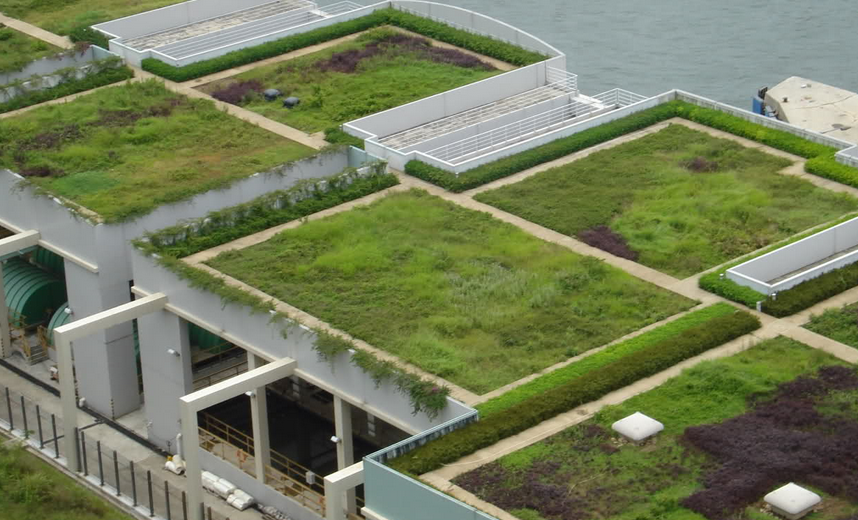Green and Cool Roofs
Green and cool roofs are innovative strategies to combat climate change by mitigating the urban heat island effect and reducing energy consumption. Green roofs are adorned with vegetation, while cool roofs are coated with reflective materials, helping to curb heat absorption and enhance energy efficiency.

Image Credit: Euractiv
View open jobs in this Solution
Example Companies
- Green Roofs for Healthy Cities - Promotes the green roof industry in North America.
- Living Roofs, Inc. - Specializes in the design and installation of green roofs.
- American Hydrotech, Inc. - Provides waterproofing and green roof solutions.
- Sika Sarnafil - Offers cool roofing systems and green roof solutions.
- GAF - Manufactures cool roofing materials and green roof systems.
Overview
Green and cool roofs are innovative strategies to combat climate change by mitigating the urban heat island effect and reducing energy consumption. Green roofs are adorned with vegetation, while cool roofs are coated with reflective materials, helping to curb heat absorption and enhance energy efficiency.
- Using Green Roofs to Reduce Heat Islands - US EPA
- Case studies for green roofs - Minnesota Stormwater Manual
Progress Made
Significant advancements have been made in green and cool roof technologies:
- Modular Green Roofs: Pre-vegetated green roofs that can be easily installed on buildings.
- Living Roofs: Green roofs with a layer of soil and vegetation that is alive and growing.
- Cool Roofs: Roofs coated with reflective materials to reduce heat absorption.
Solutions by Sector
Urban Buildings
- Residential Green Roofs: Green roofs installed on homes to reduce energy consumption and enhance aesthetics.
- Commercial Cool Roofs: Reflective roofs on commercial buildings to lower cooling costs.
- Public Buildings: Green and cool roofs on schools, hospitals, and government buildings to improve energy efficiency.
Case Studies:
- Target Center Arena, Minneapolis: Features a green roof that mitigates the urban heat island effect and manages stormwater (Minnesota Stormwater Manual).
- San Francisco Public Utilities Commission Headquarters: Incorporates a green roof to enhance energy efficiency and provide green space (Green Roofs for Healthy Cities).
- Chicago City Hall: Implemented a green roof to reduce the building's energy use and mitigate the urban heat island effect (City of Chicago).
Industrial Applications
- Warehouse Cool Roofs: Reflective roofs on warehouses to reduce cooling costs.
- Factory Green Roofs: Green roofs on factories to improve insulation and reduce energy consumption.
- Distribution Centers: Cool roofs on distribution centers to enhance energy efficiency.
Case Studies:
- Ford Motor Company, Dearborn: Features a green roof on its truck assembly plant to improve insulation and reduce energy costs (Ford).
- Target Distribution Center, California: Implemented a cool roof to lower cooling costs and improve energy efficiency (Target).
- Prologis Industrial Park, Global: Uses cool roofing systems to enhance energy efficiency across its properties (Prologis).
Policy and Advocacy
- Government Incentives: Providing financial incentives for green and cool roof installations.
- Building Codes: Implementing building codes that require or encourage green and cool roofs.
- Public Awareness Campaigns: Educating the public about the benefits of green and cool roofs.
Case Studies:
- San Francisco Green Roof Ordinance: Requires new buildings to include green roofs or solar panels (San Francisco Planning Department).
- New York City Cool Roofs Program: Encourages the installation of cool roofs to reduce energy consumption (NYC CoolRoofs).
- Toronto Green Roof Bylaw: Mandates green roofs on new developments to improve energy efficiency and manage stormwater (City of Toronto).
Lessons Learned
- Urban Heat Island Mitigation: Green and cool roofs help reduce cooling energy demand by 20-40%, mitigating the urban heat island effect.
- Stormwater Management: These roofs decrease stormwater runoff, lessening sewer system strain and flood risks.
- Air Quality Improvement: Green roofs can trap pollutants and offer urban green spaces for enhanced air quality.
- Implementation Challenges: Considerations like building codes, costs, and maintenance are crucial during project planning.
- Collaborative Efforts: Successful implementation requires collaboration among government, industry, and NGOs.
Challenges Ahead
- Enhancing Efficiency: Improving the efficiency and performance of green and cool roof technologies.
- Cost Reduction: Lowering the costs of installation and maintenance to make these solutions more accessible.
- Scaling Up Capacity: Increasing the adoption of green and cool roofs in urban areas.
- Public Awareness: Raising awareness about the benefits of green and cool roofs.
Best Path Forward
- Public Awareness: Education about the benefits of green and cool roofs is crucial.
- Incentives: Providing incentives for residential and commercial installations is essential.
- Continuous Improvement: Ongoing enhancement of technology is necessary.
- Policy Support: Implement supportive policies and building codes to encourage adoption.
- Collaboration: Foster collaboration among stakeholders to promote green and cool roof installations.
Image credit: Unsplash